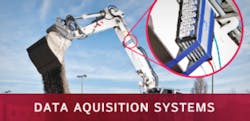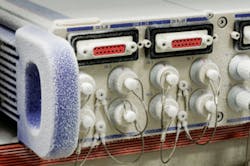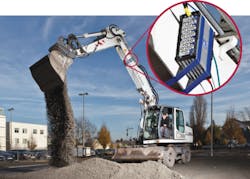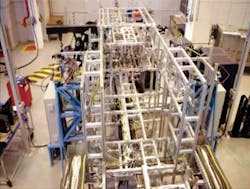The Internet of Things (IoT) is characterized by large numbers of sensors, actuators, and software modules that communicate via the Internet. Regardless of what these elements accomplish, the key feature is the use of the Internet as the system infrastructure. Several systems demonstrated at this year’s Sensors Expo operated in this way.
That’s one definition. Although the IoT terminology implies an extension of the Internet we use every day, IoT often is broadly applied to other kinds of networked systems, especially when big data is involved. As commented upon in a recent blog post by Chris DePuy, market research analyst for Dell’Oro Group, “Billions of new devices—beside mobile phones, tablets, and laptops—are expected to need network connectivity in the future in a trend known commonly as the Internet of Things. Depending on the proponent of such a trend, we often hear of the benefits expected to accrue to various technology players. For instance, those involved in the mobile phone/cellular industry point to how IoT will drive significant new connections to cellular networks. Likewise, technology companies with exposure to various forms of unlicensed wireless technology such as WLAN, Bluetooth, Zigbee, etc., talk about IoT in the context of driving growth of their particular type of networking technology.
“Recently, we estimated that there will be an installed base of nearly 1 billion WLAN network devices in five years.” DePuy concluded, “While not all these devices are publicly available for use—only their owners can use many of them—we expect that these WLAN devices will be the primary way that most IoT devices connect to networks.”1
One of the more challenging aspects of the IoT is the huge amount of data that can be generated. When the data is related to an industrial process and big-data analysis is used to optimize the process in some way, the terms industrial IoT (IIoT) and Industry 4.0 often are applied. As described in a McKinsey interview with two Robert Bosch executives, “The Internet of Things has already set in motion the idea of a fourth industrial revolution—a new wave of technological changes that will decentralize production control and trigger a paradigm shift in manufacturing. To drive development, two competencies must come together: using what’s truly new about new technologies and finding people who can design robust algorithms to make the system user-friendly.”2
A General Electric-Accenture report listed four ingredients in a recipe for operational efficiency and innovation:
- exponential growth in data volumes from sensors added to industrial equipment,
- the IoT,
- improved analysis capabilities, and
- the large economic impact that monitoring can have in some industries.
According to the report, “The resulting sum of those parts gives you the Industrial Internet—the tight integration of the physical and digital worlds. The Industrial Internet enables companies to use sensors, software, machine-to-machine learning, and other technologies to gather and analyze data from physical objects or other large data streams—and then use those analyses to manage operations and in some cases to offer new, value-added services.”3
The authors of a recent Sogeti research report observed, “Traditionally, the systems, processes, and people within IT [information technology] and OT [operational technology] have been managed, controlled, and governed independently of one another. The Internet of Things has brought greater interdependence. It has accelerated the development in which operational systems are becoming direct extensions of information systems and vice versa.” As explained in the report, Gartner defines IT as dealing with business process automation and office automation. In contrast, according to Gartner, “OT is hardware and software that detect or cause a change through the direct monitoring and/or control of physical devices, processes, and events in the enterprise.”4
Robert Bosch’s deputy chairman of the board of management, Siegfried Dais, succinctly summed up the situation, “It is highly likely that the world of production will become more and more networked until everything is interlinked with everything else.”1
Big data acquisition (DAQ) projects
Buildings
VTI Instruments’ Tom Sarfi, director of product management at the company, described a large, distributed application at Virginia Polytechnic Institute and State University. “Virginia Tech recently outfitted its Smart Infrastructure Lab with hundreds of accelerometers and incorporated VTI’s PXI Express-based data acquisition instrumentation with an LXI-PXI Express bridge interface to acquire all the data from the sensors,” he said. ”The Smart Infrastructure Laboratory (VT-SIL) mission is to advance education and research in topics that utilize sensor information to improve the design, monitoring, and daily operation of civil and mechanical infrastructure as well as to investigate how humans interact with the built environment.”
VTI’s EMX-2500 LXI-to-PXIe bridge with IEEE 1588 precision time protocol provided both accurate timestamping as well as relatively long-distance Ethernet connectivity. This approach allowed the DAQ hardware to be physically close to groups of sensors, reducing the need for extensive low-level signal cabling. Earlier attempts to address the application used smaller proprietary DAQ systems but could not provide the necessary synchronization for the widely distributed sensors.
Sarfi concluded, “… multiple EMX-4250 dynamic signal analyzer digitizers were placed in multiple CMX09 PXI Express mainframes. An EMX-2500 LXI-PXI Express bridge is installed in each of the mainframes, and all mainframes are connected to the host controller through an Ethernet switch. The EMX-4250 provides the excitation required by the accelerometers and samples all data at rates up to 204.8 kS/s/ch. The capabilities to distribute the measurements across the building through Ethernet … [and to provide] precise synchronization were the primary factors in selecting this hardware configuration.”
A Virginia Tech press release explained that in the future VT-SIL intends to make a significant amount of new data available as an open source to serve more than just the Virginia Tech community. This is the point at which connection to the Internet is important. However, for correct operation of the VT-SIL DAQ system, the Internet isn’t required.
Cars
Andrew Jesudowich, application sales and operations manager at imc DataWorks, discussed the use of his company’s rugged DAQ systems in climatic car testing. “Since 2003, FORD has been testing the performance of its cars’ HVAC (heating, ventilation and air conditioning) using imc CRONOS systems, he said. “Toward this end, up to 300 analog measurement channels are set up throughout the vehicle. Once equipped with their sensors, the vehicles are sent to the wind tunnel (test rig) or on a test drive. The test vehicles and their sensor equipment are either exposed to winter proving trials where they are cooled down to -40°C or are heated up to 80° for summer proving trials.” A very cold CRONOS-SL DAQ system is shown in Figure 1.
According to a CRONOS application note, “The PC-independent systems store their data in a 4-GB flash card, and a ‘personal analyzer’ can be used for statistics, math, or analytical online calculations. Therefore, the results are instantly available right after, or even during, the measurement. A PC or data server connection uses the built-in Ethernet interface or WLAN technology. All further analysis and documentation can be performed with the help of imc FAMOS, imc’s offline analysis tool.”5
imc LINK is a software application that supports remote data collection and transfer. As described on the company’s website, “imc LINK … seamlessly integrates with existing Internet connections such as LAN/Ethernet and WLAN/Wi-Fi and newer mobile 3G/4G data transfer technologies including GSM, GPRS, EDGE, and UMTS.”
HBM also is active in the vehicle test area and, like imc, emphasized the benefits of a rugged DAQ system. Ravi Shukla, business development manager, said, “SomatXR combines the ruggedness of HBM’s Somat eDAQ and the high-quality signal conditioning of HBM’s QuantumX system (Figure 2). Together with its IP65/IP67 protection and shock and vibration ratings according to MIL-STD-202 G, the data format and the Linux operating system allow secure long-term operation without the loss of data. In addition, HBM integrated a web server to allow the user to control the unit and visualize the data remotely, thus allowing the engineers and/or technicians to remain at a convenient place without being disconnected from their measurement.”
Courtesy of HBM
Shukla continued, “To obtain the capabilities of a distributed system, we use state-of-the-art Ethernet Precision Time Protocol version 2 so that all modules are precisely synchronized with a latency of less than 1 µs. This can allow the modules to be located next to the sensors and strain gages for the highest signal quality. To minimize the influence of noise with the input signals, SomatXR uses 24-b A/D conversion and carrier frequency excitation technology.” He concluded, “The completely new interface runs a web server so multiple clients can access the system via any standard Internet browser without the need to install software.”
Aerospace
National Instruments’ Anjelica Warren, project engineer for data acquisition, described a large test system being developed for Embraer. She said, “To innovate more quickly, companies like Embraer are using hardware-in-the-loop simulation and physical testing to test designs earlier and often. United Technologies, a supplier for Embraer, is working with NI Alliance Partner Clemessy to create a full test rig based on NI hardware and software to validate the primary flight control actuator system based on new fly-by-wire technology.” The “iron bird” test rig is shown in Figure 3.
Courtesy of Embraer
Warren continued, “In the 1990s, Embraer decided to invest more in simulated ground testing to shorten time-to-market. This allowed the company to find and fix errors before the first in-air test flight. NI’s platform was an ideal solution for Embraer because it can perform both large-scale simulation and large-scale physical test. The test rig is a PXI-based test system using LabVIEW and VeriStand.” She concluded, “The company selected a PXI-based approach because its advanced timing and synchronization features allow users to precisely synchronize tens and hundreds of test systems and thousands of channels. We consider the Embraer application as an example of the IIoT in the sense that there are several test systems connected together sharing data over a large, distributed test system, not necessarily publishing a lot of test data over the Internet around the world.”
In another NI aerospace application, Lockheed Martin developed flight simulation models using NI’s LabVIEW Simulation Interface Toolkit and PXI. Jesse Hopkins, a Lockheed employee and author of a case study on the NI website, commented, “… the system was easily controlled using the LabVIEW built-in web publishing tool. Using this tool, Lockheed engineers could interface to the PXI chassis from any desktop computer on the corporate network.”6
Trains
Keeping with the transportation theme, Yokogawa became involved in remote testing of multiple diesel-electric engines installed in passenger locomotives. William Chen, Test and Measurement Division Product Manager II, explained, “The customer was required to measure the electric power and mechanical performance of two locomotive engines in order to compare [them] under harsh environmental conditions. To meet the customers’ requirements, Yokogawa offered the ScopeCorder DL850E portable data acquisition recorder as the measurement solution.”
Chen continued, “The ScopeCorder’s modular design has up to 128 measurement channels for measuring both electrical and physical sensors. Required measurements included voltage, current, three-phase electrical power, harmonics, temperature, frequency, and vibration. Two modules that impressed the customer were the [720210] high-speed 100-MS/s isolated dual-channel module and the [701251] high-speed 1-MS/s, 16-b isolated dual-channel module. These modules provided the customer with the ability to perform isolated measurements on a three-phase engine to analyze the start-up transient signals with high resolution and high precision.”
Two additional elements completed the application solution. The /C30 GPS add-on option provided built-in synchronization of the measurement data across two or more ScopeCorder units. And, a turnkey software solution called Xviewer supported remote control of multiple ScopeCorder units as well as direct data streaming to a PC. The PC and ScopeCorders are connected via USB or Ethernet.
Physics
Oliver Rovini, technical director at Spectrum Systementwicklung Microelectronic, described how one of the company’s digitizers was used to address a high-energy physics application. “A major science laboratory required an easy way to monitor the quality of the light beam that was being generated by their synchrotron,” he said. “The instrument needed had to digitize the analog signals coming from photo-detectors that were used to observe the beam. Furthermore, the instrument had to operate remotely and transfer the collected data so that it could be shared with multiple users working on the laboratory network.”
He concluded, “The customer chose a Spectrum digitizerNETBOX model DN2.496-04, which offers four channels with sampling rates up to 60 MS/s and 16-b resolution. The product is fully LXI compliant and allows remote control and data transfer over fast Gbit Ethernet. Once connected to the company network, the unit is easy to operate and can share information with users on the network as well as others over the Internet.”
Internet-based DAQ
Measurement Computing’s (MCC’s) Peter Anderson, general manager, described how his company’s WEB-TEMP web-based temperature monitoring hardware helped solve a regulatory problem. Medpace is a leader in research-based drug and medical device development, with widely separated facilities. The company needed to develop a system to monitor temperature and humidity at all locations and report the data to the company’s Cincinnati, OH, main office.
Anderson said, “The reach of the Internet permits all these disparate facilities to be monitored from a central location and by Medpace personnel worldwide. The MCC solution also allows alarming via email and text messages if problems are detected. Medpace chose the WEB-TEMP for its accuracy and ease of configuration in remote settings and DASYLab for its quick development and extensive feature set.”
Omega Engineering’s iTHX-SD also provides temperature and humidity logging. As described by the company’s Kathy Kwait, “The iTHX-SD is simple to install and use and features Omega’s iServer technology that requires no special software except a web browser. The iTHX-SD connects to an Ethernet network with a standard RJ45 connector and sends data in standard TCP/IP packets. From within an Ethernet LAN or over the Internet, the user simply types its IP address or an easy-to-remember name in any web browser, and the iTHX-SD serves a web page with the current readings.”
Recent DAQ products
Although a few companies contacted for this article did not provide application examples, they nevertheless have been developing new products. Marvin Test Solutions’ Mike Dewey, director of marketing, emphasized the flexibility of the company’s GX3788 FPGA multifunction I/O PXI card. He said, “The GX3788 leverages the software/hardware FPGA infrastructure of our GX3700 and GX3700e PXI and PXI Express FPGA modules, allowing users to create their own customized DAQ product. We anticipate that users will take advantage of the programmable FPGA to support onboard signal processing and data reduction of acquired analog signals. And with the module supporting data streaming, it is possible for customers to continuously acquire/generate data in real time.”
United Electronic Industries’ Bob Judd, director of marketing, discussed the development of products with new capabilities. He said, “The DNx-VR-608 board is designed to directly connect to variable reluctance sensors that are used extensively in engine testing. Our recently released DNx-AFDX-664 board can interface to the new AFDX avionics bus, used by the new larger jets from AirBus and Boeing and expected to expand into new generations of smaller aircraft.”
And, Microstar Laboratories has been expanding software options that give additional capabilities to the xDAP line of Data Acquisition Processor systems. The software modules add useful features such as anti-aliasing filtering, rotating machinery analysis, time-base synchronization, and wave synchronization. These capabilities are included in the DAPtools Standard or DAPtools Professional software packages.
The state of play today
If you’re referring to a DAQ system’s connectivity, the IoT terminology can be misleading. On the other hand, if you’re discussing big-data analytics and IT-OT convergence, Industry 4.0 is a more meaningful term that doesn’t imply that the Internet is involved. As is evident from the application solutions that DAQ manufacturers submitted, many world-class test systems only use the Internet to provide remote data transfer or control and publish results. Test sequencing, measurements, data archiving, and analysis all can function locally and often are designed to do so.
Input from UEI’s Judd highlights further considerations. “We are keeping a close eye on IoT but have yet to see much demand,” he said. “As many of our products are Ethernet based, we have an ideal platform. However, it seems most of our customers either need better real-time performance than is currently possible with IoT or they have security concerns about using any off-site storage and/or any sort of Internet data transfer.”
References
- DePuy, C., “Internet of Things (IoT) and Wireless LAN (WLAN) Go Hand-in-Hand,” Dell’Oro Group, July 30, 2015.
- Löffler, M. and Tschiesner, A., “The Internet of Things and the future of manufacturing,” McKinsey Quarterly, June, 2013.
- Industrial Internet Insights Report for 2015, General Electric-Accenture, 2014.
- Bloem, J. et al, The Fourth Industrial Revolution: Things to Tighten the Link Between IT and OT, Sogeti, 2014.
- Climatic Test Measurement System, imc, Application Note 28.
- Hopkins, J., “Lockheed Martin Uses NI LabVIEW Simulation Interface Toolkit and PXI for Flight Simulation Model Development,” National Instruments, 2012.
For more information



